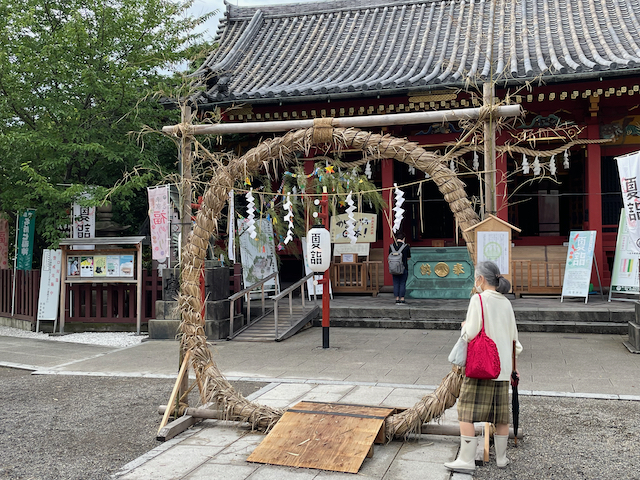Earlier this week, I volunteered to help out at Asakusa Jinja’s natsumoude. Normally, I would write that “natsumōdë”, but Asakusa Jinja has an official romanisation for the word, so I am using that.
This is, as you might guess, related to hatsumōdë. Hatsumōdë is the custom of visiting a jinja or temple in the first few days of a new year, to pray for good fortune. Natsumoude is the “new custom”, as Asakusa Jinja puts it, of visiting a jinja or temple in the first few days of July.
The jinja is entirely up-front about it being a new custom; the program book for this year’s events even says “A New Japanese Custom” on the front. (In both English and Japanese.) They do not really have any choice, as they started it eight years ago, which means that everyone remembers that they did not do this in their childhood, or indeed ten years ago.
While it is a new tradition, it is also based on practices that do go back centuries. Hatsumōdë happens immediately after the Ōharaë at the end of the year, but Ōharaë was traditionally performed at the end of the 6th month as well as at the end of the 12th month, and, indeed, the rituals at the end of June have been more popular recently. Further, when the chief priest at Asakusa Jinja did some research, he found that there were customs connected to cleaning wells in summer, which fitted with the plans. Finally, July 7th is Tanabata, which really has been celebrated for centuries, and makes a good day on which to finish natsumoude.
As natsumoude is only eight years old, the customs around it are still being developed. Asakusa Jinja was the first jinja to do it, but there are now over 250 jinja across Japan and more than a dozen temples that have adopted it, and no doubt there are differences in approach. Asakusa Jinja is the only place where I have experienced it, so my comments are based on that.
The jinja leaves the chi-no-wa, the ring of reeds set up as part of the summer Ōharaë, in place for the whole period of natsumoude, and also holds events in the jinja precincts. For example, this year there was a path surrounded by a trellis with lots of wind chimes, and people could paint their own wind chimes, hang them there for a photograph, and then take them home. There were also a number of outdoor concerts, and at the weekend (when I wasn’t present), there was a Bon-odori, a traditional Japanese summer folk dance, that apparently had never, as far as the priests know, been performed at Asakusa Jinja before. The plan is to make it a standard part of the tradition, despite the fact that the traditional date is the 15th of either July or August.
At least at Asakusa Jinja, the event also involves a number of shops in the surrounding area, both sponsoring it, and offering special gifts to people who take the natsumoude leaflet and make a purchase. Thus, it is not purely “religious” in orientation, but also intended to boost the economy of the local area.
This is one reason why this year’s event went ahead despite the pandemic, but I think it was pretty safe: it was entirely outdoors, everyone was wearing masks, and it didn’t involve people gathering in close groups for long periods of time. On the other hand, there was a constant stream of people coming to pay their respects, so I think it is working, at least to some extent.
Incidentally, I got involved in this through the “Dai Ni no Furusato”, or “Second Home Town” group that I have mentioned on this blog before. Although their main aim is to support matsuri in depopulated areas, the pandemic has made that a bit difficult. The chief priest of Asakusa Jinja is one of the organisation’s directors, so I suspect that this was done to keep the group active until things improve.
I plan to write two more blog posts about this event: one about the goshuin associated with it, and one about the well-cleaning matsuri. It may be a couple of weeks before I get them online, however.

Is Hatsumōdë about Oharae? I thought it was just to greet the Ujigami for the new year.
Hatsumōdë is not exactly about the Ōharaë, but they are at least consecutive in time, which provides an excuse for setting up a similar thing in summer.
Pingback: Asakusa Goshuin – Mimusubi
Pingback: Well-Washing Ceremony – Mimusubi
Pingback: Hōchō Shiki – Mimusubi